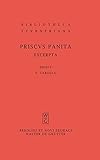Excerpta et fragmenta / Priscus Panita; Pia Carolla.
Material type: TextSeries: Bibliotheca scriptorum Graecorum et Romanorum TeubnerianaPublisher: Berlin ; Boston : De Gruyter, [2019]Copyright date: ©2008Description: 1 online resource (140 p.)Content type:
TextSeries: Bibliotheca scriptorum Graecorum et Romanorum TeubnerianaPublisher: Berlin ; Boston : De Gruyter, [2019]Copyright date: ©2008Description: 1 online resource (140 p.)Content type: - 9783110201383
- 9783110972412
- 949.5
- PA4399.P85A6 2008
- online - DeGruyter
- Issued also in print.
| Item type | Current library | Call number | URL | Status | Notes | Barcode | |
|---|---|---|---|---|---|---|---|
 eBook
eBook
|
Biblioteca "Angelicum" Pont. Univ. S.Tommaso d'Aquino Nuvola online | online - DeGruyter (Browse shelf(Opens below)) | Online access | Not for loan (Accesso limitato) | Accesso per gli utenti autorizzati / Access for authorized users | (dgr)9783110972412 |
Browsing Biblioteca "Angelicum" Pont. Univ. S.Tommaso d'Aquino shelves, Shelving location: Nuvola online Close shelf browser (Hides shelf browser)

|

|

|

|

|

|

|
||
| online - DeGruyter Restitution von Kunstwerken aus jüdischem Besitz : Dingliche Herausgabeansprüche nach deutschem Recht / | online - DeGruyter Interlingual Lexicography : Selected Essays on Translation Equivalence, Constrative Linguistics and the Bilingual Dictionary / | online - DeGruyter Sprachhandeln und Medienstrukturen in der politischen Kommunikation / | online - DeGruyter Excerpta et fragmenta / | online - DeGruyter Bibliotheksforum Bayern (BFB) : 25 Jahresregister (1973–1997) / | online - DeGruyter Aktiengesetz : Großkommentar. Lieferung 28, §§ 69-75 / | online - DeGruyter Die Tagebücher von Joseph Goebbels. Register 1923-1945. Sachregister / |
Frontmatter -- Hoc libro Continentur -- Praefatio -- Librorum conspectus -- Sigla atque breviata -- Testimonia de Prisco -- Excerpta de legationibus -- Excerpta de obsidionibus -- Excerpta de legationibus (sequuntur) -- Excerpta incertae sedis -- Fragmenta dubia -- Index nominum -- Index locorum -- Index fontium fragmentarum dubiorum -- Tabulae
restricted access online access with authorization star
http://purl.org/coar/access_right/c_16ec
Best known for his longest excerptum about Attila and the Huns, Priscus Panita survives mostly in Excerpta Constantiniana de legationibus. He describes with an impressive amount of details a Byzantine embassy and the secret plot to kill Attila in 448/449 A.D., when Priscus himself was involved in a scary situation. He also investigates Theodosius II's age around other borders, such as Caucasus and Aegypt.After a new collation and full reconsideration of all manuscripts, this critical edition provides a complete demonstration of the stemma codicum and an accurate apparatus, both philological desiderata for long. The text is plain and fluent, a good example of V century A.D. rhetorical prose, with a wide range of loci similes in classic authors and a special skill for variatio. From a historical point of view, some nations from Eastern Europe, Asia and Africa find in Priscus a unique source for their roots.
Diese Exzerpte – von einem Griechen verfasst, der Teilnehmer einer Gesandtschaft bei Attila war – spiegeln nachhaltige Eindrücke von Gesellschaft, Macht und Intrigen im Byzanz des 5. Jh. wider, die sich in hohem Maße auf Attila und die Hunnen allgemein beziehen. Vom historischen Standpunkt aus gesehen finden einige Nationen von Osteuropa, Asien und Afrika bei Priscus einzigartige Quellen für ihre Wurzeln. Für Philologen füllt diese Edition, die mit einem sorgfältig erarbeiteten textkritischen Apparat und einer vollständigen Darstellung der handschriftlichen Überlieferung ausgestattet ist, eine Lücke im Textangebot.
Issued also in print.
Mode of access: Internet via World Wide Web.
In Greek, Ancient (to 1453).
Description based on online resource; title from PDF title page (publisher's Web site, viewed 28. Feb 2023)


